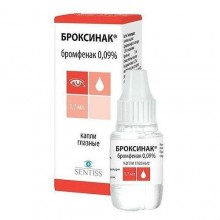



Bromfenac is a non-steroidal anti-inflammatory drug (NSAID), which has anti-inflammatory and analgesic effects, blocks the synthesis of prostaglandins from arachidonic acid by inhibiting cyclooxygenase 1 and 2, which leads to a decrease in inflammation and a decrease in the pain response.
In vivo studies have shown that prostaglandins are mediators of certain types of eye inflammation. In animal studies, prostaglandins contributed to the violation of the hematophthalmic barrier, increased vascular permeability, caused vasodilation, leukocytosis, increased intraocular pressure.
Treatment of postoperative inflammation and pain reduction in patients after cataract extraction.
The composition of the substance includes one active ingredient bromobenac sodium sesquihydrate at a concentration of 0.9 mg in 1 ml of solution.
Among the auxiliary components in the solution there are: benzalkonium chloride (0.05 mg), polysorbate 80 (1.5 mg), disodium dihydrate edetate (0.2 mg), povidone K-30 (20 mg), anhydrous sodium sulfite (2 mg ), sodium borate decahydrate (11 mg), sodium hydroxide to create an optimum pH of 8.3, water for injection.
No customer reviews for the moment.
Installations in the conjunctival sac
One drop once a day. Treatment begins 1 day before surgery and continue for the first 14 days of the postoperative period (including the day of surgery).
Instructions in case of missing one or more doses of the drug
If you miss the drug should apply the medication as soon as possible in the dosage prescribed by the instruction. If the pass in the use of the drug is approaching 24 hours, the drug should be applied at the next scheduled time, not doubling the dose to compensate for the missed dose.
Violations by the organs of sight:
Often (observed in 2-7% of patients): discomfort and unusual sensations in the eyes, eye irritation, pain, itching and burning in the eyes, redness of the eyes, conjunctival hyperemia, inflammation of the iris.
Very rarely: there are isolated post-marketing reports about corneal erosion, corneal perforation, corneal thinning, epithelial destruction.
Nervous system disorders: headache.
With the double use of a 0.09% solution of bromfenac, the following reactions were also observed:
Violations by the organs of sight:
Sometimes: reduced visual acuity, retinal hemorrhage, corneal edema, photophobia, bleeding from eyelid vessels, exudates in the fundus.
Seldom: corneal ulcer,
Disorders of the respiratory system, organs of the chest and mediastinum: epistaxis, cough, nasal discharge, asthma.
General disorders and disorders at the site of administration: swelling of the face.
Carefully: Sodium sulphite contained in a preparation can cause an allergic reaction, including anaphylactic shock, asthma attacks in susceptible people. Sensitivity to sulfites is increased in individuals with bronchial asthma and a history of allergic reactions.
When using the drug Broxinac there is the possibility of cross-sensitivity to acetylsalicylic acid, derivatives of phenylacetic acid, as well as other NSAIDs. Care must be taken when treating individuals who have previously detected sensitivity to these drugs.
NSAIDs can increase bleeding time as a result of a violation of platelet aggregation. The use of local NSAIDs in combination with ophthalmologic operations can increase bleeding of eye tissues (including in the anterior chamber of the eye). Broxinac should be used with caution in patients with a history of a tendency to bleeding, or if patients receive other medications that can increase blood clotting time.
Experience with local NSAIDs shows that patients with complications from surgical ophthalmologic interventions, corneal denervation, corneal epithelium defects, diabetes, superficial eye diseases (for example, dry eye syndrome), rheumatoid arthritis, or repeated surgical interventions performed during a short period time, may have an increased risk of corneal adverse reactions.
Use in children
The drug can be used simultaneously with other ophthalmologic drugs: α-adrenomimetics, β-adrenoblockers, carbonic anhydrase inhibitors, mydriatics. In this case, the drugs should be used with a break of at least five minutes.
Pregnancy
The safety of using bromfenac 0.09% eye drops during pregnancy has not been studied. However, data from some animal embryotoxicity studies indicate the possibility of reducing the viability of the embryo. The use of the drug is possible if the expected effect for the mother outweighs the potential risk to the fetus. You should avoid the appointment of the drug in late pregnancy.
Breastfeeding period
Caution must be exercised when used in women during breastfeeding.
The use of local NSAIDs for 24 hours before surgery on the eyes and within 14 days after the ophthalmic surgery, may increase the risk of and the severity of adverse reactions from the cornea.
The use of local NSAIDs can lead to the development of keratitis. In some susceptible patients, long-term use of local NSAIDs can cause epithelial rupture, corneal thinning, corneal erosion, ulceration of the cornea, or corneal perforation. These side effects may create a risk of vision loss. Patients with signs of corneal epithelium rupture should immediately discontinue use of the drug and be under medical supervision until the cornea is normalized.
The use of NSAIDs may slow down the healing process, especially when used in conjunction with local corticosteroids. Patients should be warned that delayed healing may occur during the use of NSAIDs.
When using the drug Broxinac patients should not use contact lenses.
Patients should be warned that they do not touch the tip of the dropper and do not touch them on any surface; this can lead to contamination of the contents of the vial.
Influence on ability to drive motor transport and control mechanisms
The drug has a slight effect on the ability to drive vehicles and control mechanisms. Perhaps a short-term blurred vision after the injection, it is therefore recommended to wait until full recovery of vision, before proceeding to drive vehicles and control mechanisms.
If you accidentally use the drug inside, you should immediately drink a large amount of liquid to reduce the concentration of the drug in the stomach.